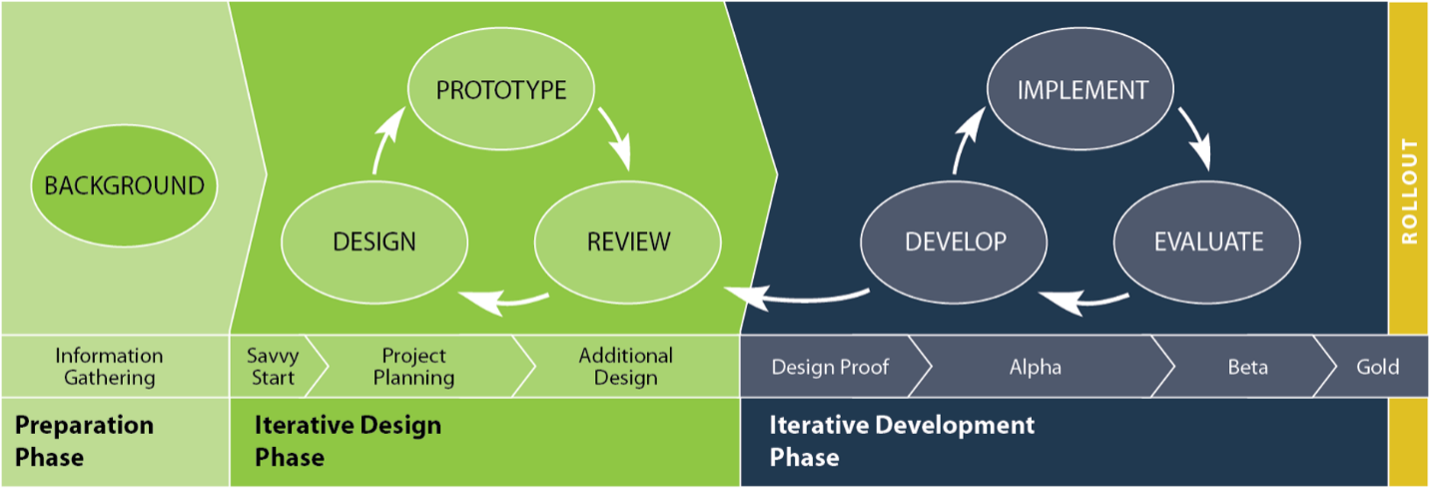Successive Approximation Model (SAM)
Table of Contents
- Overview
- The Model
- Using SAM to Create or Revise an Assignment or Project
- Pros
- Cons
- Resources
- References/Recommendations
The Successive Approximation Model (SAM) is a simplified version of the ADDIE Model designed specifically to elicit feedback and build working models earlier in the process. Developed by Dr. Michael Allen of Allen Interactions, this model uses a recursive rather than linear process for course development. The simplest SAM model is composed of three parts: Preparation, Iterative Design, and Iterative Development. The key word here is iterative, which is the basis for this model and signals that each step is meant to be repeated and revisited.
The Preparation phase begins with gathering all needed information and context for the project; the content and scope of this phase will vary greatly depending on the project or course. The hallmark of the end of the first phase of this model is the “Savvy Start”, which encourages brainstorming, sketching, and prototyping and involve as many interested parties as you can as you develop the material: colleagues, advisors, and, if you’re lucky enough to have them as a resource, students.
In the second, Iterative Design phase, the goal is to design and prototype the material so that it can be evaluated by the interested parties. The logic here is that it is easier to give feedback and evaluate a product that exists rather than one that is only an idea and allows for more extensive review and testing.
In the final Iterative Development phase, the finished prototype is fully developed and implemented. Once it has been used, it can be evaluated and run back through development and implementation phases, if necessary.

- Preparation Phase: Information Gathering and Background
- Iterative Design Phase: Design, Prototype, and Review
- Iterative Development Phase: Develop, Implement, and Evaluate
Many of you may teach the same course semester after semester, so you are probably already using some form of SAM. You likely noticed something in an assignment or project did not work as you had intended, so you make changes to that piece before the following semester.
Your process may look something like this:
Step One: Gather Materials
Step Two: Meet with your Team (Colleagues, students, etc.)
Step Three: Create a Prototype of the Assignment
Step Four: Ask for feedback
Step Five: Make changes
- Allows for constant reevaluation and assessment of materials
- Elicits feedback from all interested parties
- Developed rapidly
- Can be a time-consuming and clunky process
- Can lack cohesion due to the inclusion of so many different voices
- Is more concerned with engagement than effective learning
Leaving ADDIE for SAM: An Agile Model for Developing the Best Learning Experiences [E-Book]
Advanced Instructional Design for Successive E-Learning: based on the Successive Approximation Model (SAM) [Journal Article]
-
References/Recommendations
Adams, T. (2017, Oct. 13). Would you leave ADDIE for Sam?. Embridge Consulting. Retrieved from: https://embridgeconsulting.com/addie-sam-instructional-design-method/
Allen Interactions. (2021). E-Learning development with SAM. Allen Interactions. Retrieved from: https://www.alleninteractions.com/services/custom-learning/sam/elearning-development
Mazhar, W. (2018, Oct. 31). Sam model: Best instructional design model for short deadlines and staying on budget. 360eLearning. Retrieved from: http://360elearning.com/blog/sam-model-best-instructional-design-model-for-short-deadlines-and-staying-on-budget/
Jung, H., Kim, Y., Lee, H., & Shin, Y. (2019). Advanced design for successive E-Learning: Based on the successive approximation model (SAM). International Journal on E-Learning. 18(2), 191-204.
Rimmer, T. (2016). An introduction to SAM for instructional designers. Articulate Global, Inc. Retrieved from https://community.articulate.com/series/trina-s-articles-6cdd12e9-9841-4136-bf3c-31b0915519e1/articles/an-introduction-to-sam-for-instructional-designers
Sites, R. (2021). How do I do a savvy start?. Allen Interactions. Retrieved from: https://info.alleninteractions.com/iterative-design-in-action-implementing-the-savvy-start











